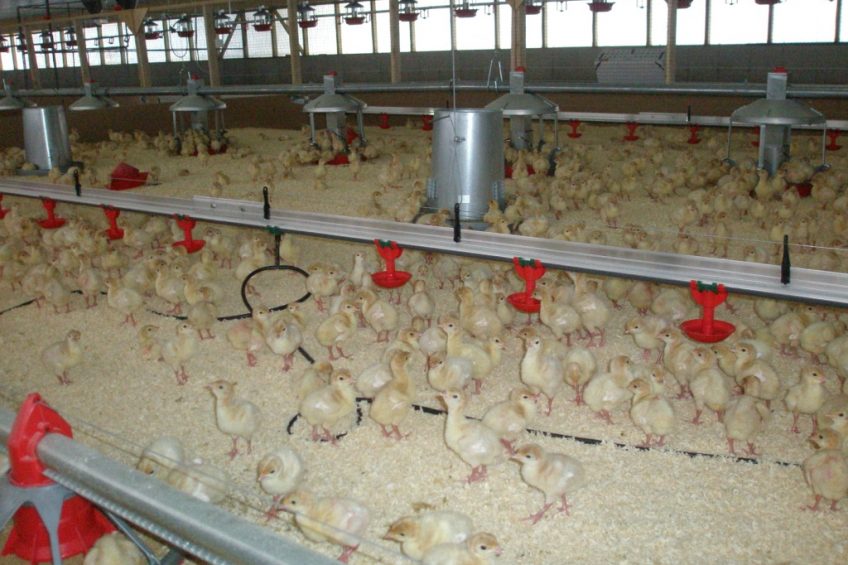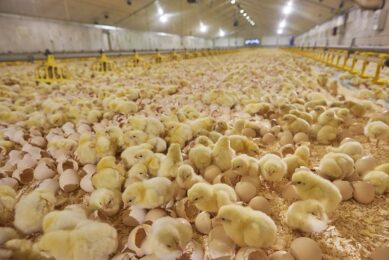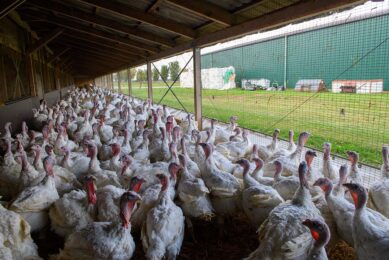Improving breast meat yield starts in the hatchery

The primary objective of a turkey hatchery is to achieve the highest possible number of poults from the eggs. Other factors may even be more important however. The incubation conditions strongly influence growth of the breast muscle during embryonic development and the potential impact on breast meat yield.
By Technical Team, Hybrid Turkeys, Kitchener, Ontario, Canada
The turkey breast muscle is conspicuously the largest single muscle in the turkey. At hatch the breast muscles can account for 35% or more of the poult’s weight. The basic (gross) structure of the breast muscle is rather simple; its physiology, not so. Muscles are composed of bundles of muscle fibres bound inside a connective tissue sheath which terminate in tendons that are attached to the skeleton. Interspaced between the muscle bundles are blood vessels and nerves.
If we examine a cross section of breast muscle from a newly hatched poult and compare it to that of the adult, we find the same basic structure with the exception that the diameter of the muscle fibres are five to 10 times larger in the adult. After a poult hatches, breast muscle grows principally by increasing the diameter and length of the muscle fibres. In contrast, the liver or heart will continue to grow by adding more new cells. In fact, at the time of hatch, the turkey’s breast muscle will contain essentially all the muscle fibres it will ever have.
Growth rate doubled
During embryonic development, precursor cells – called myoblasts – differentiate and become satellite cells. They are called satellite cells because their nuclei are strategically situated along the periphery of the muscle fibres where they presumably control metabolic functions of the muscle. These satellite cells give rise to myofibrils which make up the muscle fibres. Satellite cells continue to divide through late embryonic development, but cease creating more myofibrils shortly after the poult hatches.
During embryonic development, precursor cells – called myoblasts – differentiate and become satellite cells. They are called satellite cells because their nuclei are strategically situated along the periphery of the muscle fibres where they presumably control metabolic functions of the muscle. These satellite cells give rise to myofibrils which make up the muscle fibres. Satellite cells continue to divide through late embryonic development, but cease creating more myofibrils shortly after the poult hatches.
This feature of muscle growth is rather interesting if we consider what has taken place over the last several decades of intensive selection for growth and increased breast muscle mass in turkeys. The growth rate potential (weight for age) of the commercial turkey has more than doubled in the last three decades, while egg size and hatch weight have increased by a mere 2-3%, and incubation time has remained virtually unchanged.
Maximum hatch
If the embryonic development of satellite cells is critical to development of the maximum number of myofibres, then incubation conditions likely play an important role in the post hatch development of breast muscle. The primary goal in most hatcheries is to achieve the maximum hatch of fertile eggs. The possibility that incubation conditions could impact breast meat yield is not generally appreciated. However, based on our knowledge of embryonic development, adverse conditions (i.e. high temperature and low oxygen levels) in the hatcher during the pipping stage likely have a detrimental effect on satellite cell activity and consequently on breast development post hatch (and other tissues as well).
If the embryonic development of satellite cells is critical to development of the maximum number of myofibres, then incubation conditions likely play an important role in the post hatch development of breast muscle. The primary goal in most hatcheries is to achieve the maximum hatch of fertile eggs. The possibility that incubation conditions could impact breast meat yield is not generally appreciated. However, based on our knowledge of embryonic development, adverse conditions (i.e. high temperature and low oxygen levels) in the hatcher during the pipping stage likely have a detrimental effect on satellite cell activity and consequently on breast development post hatch (and other tissues as well).
Timing of the hatching process is considered critical for optimum labour utilisation in hatcheries. However, one consequence of a high and uniform hatch (e.g. a narrow hatch window) is that there may be an increase in carbon dioxide, a decrease in oxygen, and an increase in temperature, especially in the core of hatch racks during peak pipping and hatching.
This situation most often occurs in cold weather when hatch rates are high and outside temperatures are low. It is not uncommon for carbon dioxide levels to increase 10-fold or more, oxygen levels to decrease by 15%, and for the core of hatch racks to exceed 107°F (41.5°C) during peak hatching. The most obvious consequences of these aberrant conditions are increased early poult mortality (starve-outs and flipovers), an increase in ascites, and an increased incidence in the condition commonly referred to as “roundheart syndrome”. The more subtle (but possibly more costly) and unseen effect may be a reduction in satellite cell proliferation.
Predictable pattern
Satellite cell activity and myofibre development do not cease in all poults simultaneously. Poults hatch over an extended period of time, and those poults which hatch late (i.e. during the last 12-24 hours in the hatcher) may in fact still exhibit satellite cell activity and myofibre development for another 24 to 48 hours post hatching. Therefore, poult holding room and delivery vehicle conditions, brooder house ventilation, and early poult nutrition (as well as presentation of feed and water) also become critical for optimum breast muscle development.
Satellite cell activity and myofibre development do not cease in all poults simultaneously. Poults hatch over an extended period of time, and those poults which hatch late (i.e. during the last 12-24 hours in the hatcher) may in fact still exhibit satellite cell activity and myofibre development for another 24 to 48 hours post hatching. Therefore, poult holding room and delivery vehicle conditions, brooder house ventilation, and early poult nutrition (as well as presentation of feed and water) also become critical for optimum breast muscle development.
Breast muscle yield (irrespective of live weight) in commercial turkeys is dynamic and follows a very predictable seasonal pattern. This pattern is repeated year after year, across different strains of turkeys, different nutritional planes, and different geographical locations. It is tempting to jump to the conclusion that this seasonal trend is largely explained by increased environmental temperature and slower growth rates, but we are reminded that even flocks of turkeys which grow at near peak performance during this period exhibit depressed breast meat yield compared to other seasons of the year. Photoperiod (day length) may also play a role, but this has not yet been confirmed.
Consider still another possibility: Traditionally the lowest percent breast meat yield in turkey males grown in North America occurs during the months of July through September. These flocks are hatched during the months of February, March and April. These are some of the coldest months of the year, but also months when temperatures vary considerably from day to day and hatchability rates are traditionally near peak levels.
Unless increased ventilation and oxygenation of incubating eggs during peak hatching periods is practised, this combination of factors is ideal for creating “out of bounds” conditions in the incubator and hatching cabinets and may therefore be partially responsible, along with high environmental temperature, for the seasonal decline in both growth rate and breast meat yield. If the disproportionate increase in egg/poult size continues as growth potential increases, current incubation systems may present a bottleneck for achieving optimum performance.
Optimising overall system
Market conditions are changing and the growth rate potential of commercial turkeys continues to increase making it possible that even larger turkeys may be grown in the future. One only has to look to the pedigree level of the breeding programme to see that the genetic potential for growth rate is far from being exhausted. However, as genetic potential improves so must a company’s resource management. Managing a resource such as the hatchery, based solely on hatch of fertile eggs is an example where optimisation of a single process might be achieved, but to the detriment of optimising the overall system.
Market conditions are changing and the growth rate potential of commercial turkeys continues to increase making it possible that even larger turkeys may be grown in the future. One only has to look to the pedigree level of the breeding programme to see that the genetic potential for growth rate is far from being exhausted. However, as genetic potential improves so must a company’s resource management. Managing a resource such as the hatchery, based solely on hatch of fertile eggs is an example where optimisation of a single process might be achieved, but to the detriment of optimising the overall system.
Join 31,000+ subscribers
Subscribe to our newsletter to stay updated about all the need-to-know content in the poultry sector, three times a week. Beheer
Beheer








 WP Admin
WP Admin  Bewerk bericht
Bewerk bericht